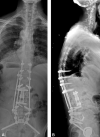Failure in Lumbar Spinal Fusion and Current Management Modalities
- PMID: 33994880
- PMCID: PMC8110346
- DOI: 10.1055/s-0041-1726102
Failure in Lumbar Spinal Fusion and Current Management Modalities
Abstract
Lumbar spinal fusion is a commonly performed procedure to stabilize the spine, and the frequency with which this operation is performed is increasing. Multiple factors are involved in achieving successful arthrodesis. Systemic factors include patient medical comorbidities-such as rheumatoid arthritis and osteoporosis-and smoking status. Surgical site factors include choice of bone graft material, number of fusion levels, location of fusion bed, adequate preparation of fusion site, and biomechanical properties of the fusion construct. Rates of successful fusion can vary from 65 to 100%, depending on the aforementioned factors. Diagnosis of pseudoarthrosis is confirmed by imaging studies, often a combination of static and dynamic radiographs and computed tomography. Once pseudoarthrosis is identified, patient factors should be optimized whenever possible and a surgical plan implemented to provide the best chance of successful revision arthrodesis with the least amount of surgical risk.
Keywords: lumbar spinal fusion; neurosurgery; pseudoarthrosis; spine surgery.
Thieme. All rights reserved.
Conflict of interest statement
Conflict of Interest None declared.
Figures




References
-
- Albee F H. Transplantation of a portion of the tibia into the spine for Pott's disease. J Am Med Assoc. 2007;460:14–6. - PubMed
-
- Rajaee S S, Bae H W, Kanim L E, Delamarter R B. Spinal fusion in the United States: analysis of trends from 1998 to 2008. Spine. 2012;37(01):67–76. - PubMed
-
- Burchardt H, Enneking W F. Transplantation of bone. Surg Clin North Am. 1978;58(02):403–427. - PubMed
-
- Kalfas I H. Principles of bone healing. Neurosurg Focus. 2001;10(04):E1. - PubMed
-
- Khan S N, Cammisa F P, Jr, Sandhu H S, Diwan A D, Girardi F P, Lane J M. The biology of bone grafting. J Am Acad Orthop Surg. 2005;13(01):77–86. - PubMed
Publication types
LinkOut - more resources
Full Text Sources
Other Literature Sources

